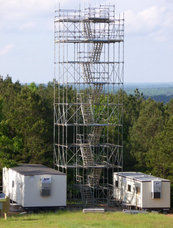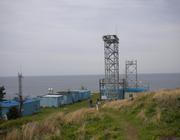
The Tropospheric Oxidation Capacity Research Group
Biosphere-Atmosphere-Human Interactions
3216 Croul Hall Irvine CA 92627 (email)

Observations of heterogeneous reactions between Asian pollution and mineral dust over the Eastern North Pacific during INTEX-B
Journal:
Atmospheric Chemistry and PhysicsVolume Number:
9Issue Number:
21Pages:
8283-8308Abstract:
In-situ airborne measurements of trace gases, aerosol size distributions, chemistry and optical properties were conducted over Mexico and the Eastern North Pacific during MILAGRO and INTEX-B. Heterogeneous reactions between secondary aerosol precursor gases and mineral dust lead to sequestration of sulfur, nitrogen and chlorine in the supermicrometer particulate size range. Simultaneous measurements of aerosol size distributions and weak-acid soluble calcium result in an estimate of 11 wt% of CaCO(3) for Asian dust. During transport across the North Pacific, similar to 5-30% of the CaCO(3) is converted to CaSO(4) or Ca(NO(3))(2) with an additional similar to 4% consumed through reactions with HCl. The 1996 to 2008 record from the Mauna Loa Observatory confirm these findings, indicating that, on average, 19% of the CaCO(3) has reacted to form CaSO(4) and 7% has reacted to form Ca(NO(3))(2) and similar to 2% has reacted with HCl. In the nitrogen-oxide rich boundary layer near Mexico City up to 30% of the CaCO(3) has reacted to form Ca(NO(3))(2) while an additional 8% has reacted with HCl. These heterogeneous reactions can result in a similar to 3% increase in dust solubility which has an insignificant effect on their optical properties compared to their variability in-situ. However, competition between supermicrometer dust and submicrometer primary aerosol for condensing secondary aerosol species led to a 25% smaller number median diameter for the accumulation mode aerosol. A 10-25% reduction of accumulation mode number median diameter results in a 30-70% reduction in submicrometer light scattering at relative humidities in the 80-95% range. At 80% RH submicrometer light scattering is only reduced similar to 3% due to a higher mass fraction of hydrophobic refractory components in the dust-affected accumulation mode aerosol. Thus reducing the geometric mean diameter of the submicrometer aerosol has a much larger effect on aerosol optical properties than changes to the hygroscopic: hydrophobic mass fractions of the accumulation mode aerosol. In the presence of dust, nitric acid concentrations are reduced to <50% of total nitrate (nitric acid plus particulate nitrate). NO(y) as a fraction of total nitrogen (NO(y) plus particulate nitrate), is reduced from >85% to 60-80% in the presence of dust. These observations support previous model studies which predict irreversible sequestration of reactive nitrogen species through heterogeneous reactions with mineral dust during long-range transport.
Notes:
Times Cited: 26
Related External URL:
<Go to ISI>://WOS:000271715500011- Citation:
- McNaughton, CS, Clarke AD, Kapustin V, Shinozuka Y, Howell SG, Anderson BE, Winstead E, Dibb J, Scheuer E, Cohen RC et al.. 2009. Observations of heterogeneous reactions between Asian pollution and mineral dust over the Eastern North Pacific during INTEX-B. Atmospheric Chemistry and Physics. 9(21):8283-8308.

